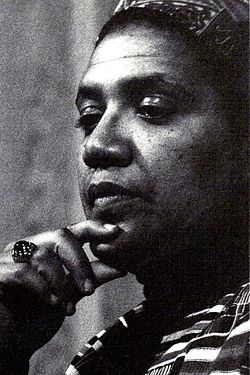More actions
< Poetry
Added Bukowski. |
m Updated name and link. |
||
| Line 64: | Line 64: | ||
| colspan="3" | {{Line}} | | colspan="3" | {{Line}} | ||
|- style="font-align: left;" | |- style="font-align: left;" | ||
| colspan="3" | {{Big|Audre | | colspan="3" | {{Big|Audre Lorde}} | ||
|- style="vertical-align: top;" | |- style="vertical-align: top;" | ||
| colspan="2" |{{bulleted list|“[[ | | colspan="2" |{{bulleted list|“[[Who Said It Was Simple]]”}} | ||
| [[File:Audre Lorde.jpg|thumb|200px]] | | [[File:Audre Lorde.jpg|thumb|200px]] | ||
|- | |- | ||
Latest revision as of 10:40, 2 April 2025
Poetry after World War II is often referred to as the "post-war" or "contemporary" period.
General Characteristics
|
|---|
|
Some general characteristics of contemporary poetry include:
These characteristics are not exhaustive, and there is considerable variety and diversity within post-war poetry. However, they provide a sense of some of the key features of the period. |
| Maya Angelou | ||
| Margaret Atwood | ||
| ||
| Gwendolyn Brooks | ||
| Charles Bukowski | ||
| Constantine Cavafy | ||
 | ||
| Lucille Clifton | ||
| Allen Ginsburg | ||
 | ||
| Audre Lorde | ||
 | ||
| Philip Larkin | ||
| Robert Lowell | ||
 | ||
| Edna St. Vincent Millay | ||
|
 | |
| Adrienne Rich | ||
| Carl Sandberg | ||
| ||
| Patricia Smith | ||
| Mark Strand | ||
| Derek Walcott | ||
|
 | |
